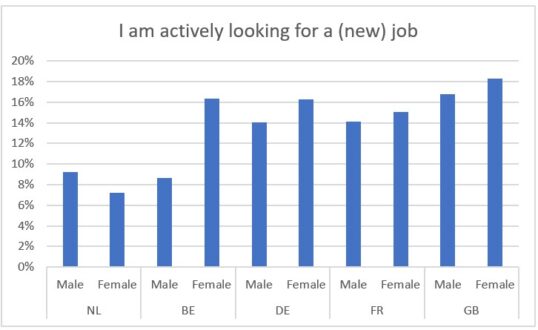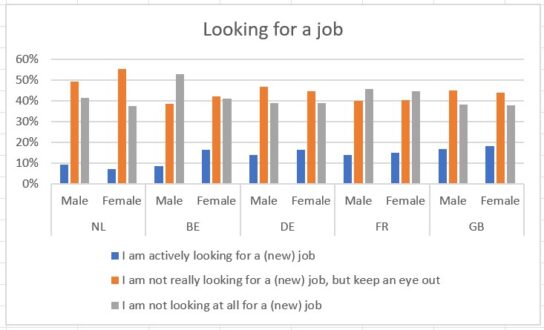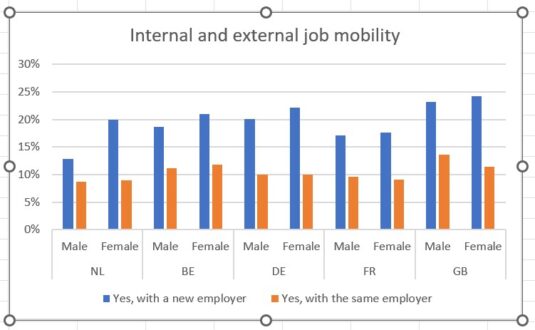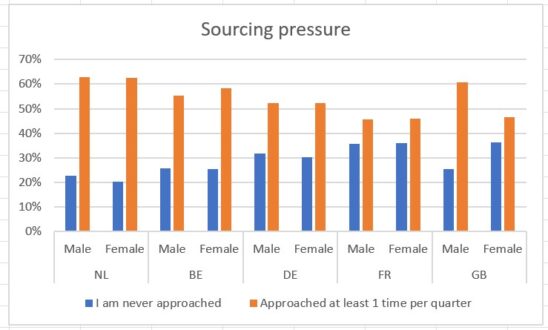
5% of the European workforce works in IT, a total of 12 million people. 19% of them are women. Among young people, the picture is slightly more favourable: of the 18 million graduates in this field, 19.4% are women. But then there is also the problem that a much lower percentage of graduates end up in IT. McKinsey recently calculated that if the share of women in the tech population doubles by 2027 (so to about 40%), the European economy would improve by about 260 to 600 billion (!) euros.
If the share of women in IT doubles, the European economy would gain between 260 and 600 billion (!) euros.
So there is still room for improvement, Liesbeth Ruoff-van Welzen observes dryly. For years she was a manager in the IT industry and at the government, now she is trying to increase the proportion of women in ‘her’ sector on a European scale at the KNVI (platform for Professionals in Information Management, Information Technology and Information Provision) and also to strengthen the professionalization of the IT profession, “because it is incoherent like loose sand. I don’t want only Google or Microsoft to have anything to say about certificates and diplomas.”
Role model
Ruoff-van Welzen recently asked Intelligence Group for data, in order to get a better and up-to-date picture of the sector and to see how the situation can be improved. “In 20 years, I’ve never been surprised that I was a woman in the tech world, that situation had grown so naturally. Now people want me to be a role model, but I prefer to look at data for inspiration.”
This data shows, for example, that women in the tech sector are predominantly more and more actively looking for a job in almost all of Europe than men. Except in the Netherlands. In any case, you see less labour market activity of IT professionals here, but even less among women than among men. Compared to the other countries, Belgian women in particular stand out with more than 16% active job seekers, compared to 8% among their male southern neighbours.
Wrong progressive perception
Unlike many other European countries, the Dutch government said after World War II that the men had to earn the money for the whole family. At the time, women were still fired when they got married. “But not in Belgium. Not in England. There, it has remained much more normal for men and women to take care of the family income together,” says Ruoff-van Welzen.
“The Netherlands’ disadvantage compared to, for example, England has still not caught up in terms of working women.”
Many people have the perception that there are so many working women in the Netherlands. “Funny,” she calls it. “But if an American colleague asked me if there were more female managers than just me, I had to answer in the negative. The progressive perception of our country is wrong, especially in the IT sector. That old post-war situation still continues. The gap compared to, for example, England has still not been made up. In other countries, IT women are looking for more opportunities, they have to.”
The Dutch are champions in the amount of latent, passive job seekers, with the men leading the way: 49%. This is related to the fact that they also have the lowest share of active searchers here. If we look at where IT professionals are not looking for a (new) job at all, Belgian men stand out with 53%, and women with 41%. Ruoff points to the large growth of self-employed people in our country as an explanation. “We have a huge self-employed community; that creates a different situation. Self-employment gives more freedom. We earn enough, we are incredibly rich, there is so much well cared for in this country. Then looking for a job, whether latent (passive) or not, takes on a completely different dimension.”
If you look at the total mobility on the labour market, i.e. changing jobs, Dutch IT men appear to be the most stable (both in their current job and with their current employer). In Great Britain, mobility is much greater, both internally and externally within and externally. More than a third are on the move in the labour market every year, the vast majority of whom find new employment with another employer.
If we look at the sourcing pressure, i.e. how often IT professionals are actively approached for another job, that pressure appears to be highest in the Netherlands, remarkably much higher than in other countries. Only the British male IT professional comes close to that. But even more striking is the difference in Britain between men and women. British women are substantially less approached for IT positions than their male counterparts. In Germany and Belgium, men and women are much more equal, with Belgian women even being approached slightly more than men.
Pullfactors
European Women (IT)
- Ability to work from home
- Health insurance
- Facilities for working from home
- Study budget
- Flexible hours
European Men (IT)
- Company car
- Bonus
- Pension
- 13th month
- Advantages of employer’s products
A feast of recognition
In Great Britain, IT women aim more for salary and less for a permanent contract, Belgian women opt for substantively interesting work, Dutch women experience the most sourcing pressure. For example, in the data from the European job market for IT women, there appear to be quite large differences. Experienced expert Liesbeth Ruoff knows where the women’s techie shortage comes from and is committed to ensuring that women stay in the sector after their studies. “It just makes money when you bring women in.”
“It just makes money when you bring women in.”
Ruoff thinks these pull factors are a feast of recognition. “If you’re reading this, you’ll understand that at the coffee machine, men speak to men and women to women. Women don’t talk about the lease car. I never thought about it that way myself, I got a company car. I chose dexterity, neatly within budget, the men opted for power of engine. They were jealous of me, because I had the fast engine! A colleague wanted to borrow my car, and promptly drove it into the dump. Men want perks, women flexible hours to be able to arrange the home front.”
High turnover
Ruoff points out that employers need to pay much more attention to these pull factors in order to bring women into the IT sector. The World Economic Forum’s just-released Future of jobs report confirms Intelligence Group’s data that employers need to offer change to their employees. “European IT women now do not want to go up internally, but to other employers. That leads to a lot of turnover, about 20 percent. If you have to attract and train new people all the time, you’re really the bastard.”
“If they leave their gender biases at home, recruiters can recruit a lot more female candidates.”
She urges employers not to look at resumes so frantically. “Women are good at analytical and creative thinking, use those skills! Upskilling and reskilling; it just makes money when you bring women in. The women who are now studying IT are not going to close the gap with men. So we have to find women from other sectors.” Recruiters overestimate the technical skills needed to work in the IT sector, Ruoff says. “Dealing with data? Has nothing to do with technology.” If they leave their gender biases at home, she says, they can recruit many more female candidates.
Onus is on leadership
British IT women consider the content of their work more important (28%) than men (23%), but much less than women in the Netherlands and Belgium (43%). “As a British IT woman, it’s much easier to move up and make a career than here,” says Ruoff. “Women just demand that there. Very different from Germany, where it is a huge job to be heard as a woman. Catching up like that takes a very long time. When I started working, a German told me: put all your energy on your job. But she also said: make sure you have children, otherwise we will die out. With such a double task, it is much more difficult to be seen as a woman, which takes more energy.”
“Why not scrum sessions at 12 o’clock, in the middle of the day, so that parents with children can also participate?”
From the current 20% or so women to 50%, is that possible? Ruoff: “It can grow. To give you an idea: when I became a boss at a company, there were mainly men there. Within a few years we had the opposite situation and the male/female ratio had become 40/60%. I think it was in my leadership, which made it easy for women to come to us. The working climate in IT can be much more woman-friendly. For example, you have those scrum sessions, all the team members together. Beautiful. But why not at 12 o’clock, in the middle of the day, so that parents with children can also participate? Don’t rule on times, but on results.”












